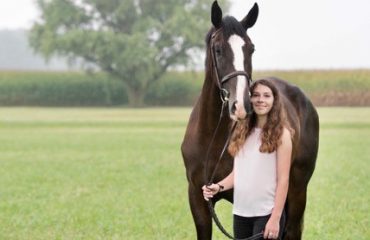 Richard Wheeler, DVM, was born in the U.K. and graduated from the Royal Veterinary College, London, in 2002. Dr. Wheeler then completed a two-year internship at Greenwood, Ellis and Partners (now Newmarket Equine Hospital) in Newmarket. In 2005, he moved to Wellington, Florida, to join Palm Beach Equine Clinic and he became a partner in 2009. Dr. Wheeler’s primary concentration is equine sports medicine. He is an FEI Veterinary Delegate for show jumping and dressage and has authored several published articles on the topic of equine sports medicine. Dr. Wheeler has served on the board of the USHJA Horse and Rider Advocates Committee. In 2016, Dr. Wheeler became a founding director of the Sport Horse Research Foundation. Dr. Wheeler and his wife, Jessica, have two children. Do you have a question you want Dr. Wheeler to answer? Send questions to editor@sidelinesnews.com.
Richard Wheeler, DVM, was born in the U.K. and graduated from the Royal Veterinary College, London, in 2002. Dr. Wheeler then completed a two-year internship at Greenwood, Ellis and Partners (now Newmarket Equine Hospital) in Newmarket. In 2005, he moved to Wellington, Florida, to join Palm Beach Equine Clinic and he became a partner in 2009. Dr. Wheeler’s primary concentration is equine sports medicine. He is an FEI Veterinary Delegate for show jumping and dressage and has authored several published articles on the topic of equine sports medicine. Dr. Wheeler has served on the board of the USHJA Horse and Rider Advocates Committee. In 2016, Dr. Wheeler became a founding director of the Sport Horse Research Foundation. Dr. Wheeler and his wife, Jessica, have two children. Do you have a question you want Dr. Wheeler to answer? Send questions to editor@sidelinesnews.com.
I recently found that after a few years of showing, my horse has developed a severe joint problem in her neck. I’ve read it’s a difficult injury to overcome, however IRAP therapy is a new approach that can help relieve pain and eventually treat her. What is your experience with IRAP therapy? Has it been successful, or is there a treatment that’s even more effective?
Injury and disease of the cervical facet joints (the joints allowing movement between vertebrae of the neck) are seen in competition horses at all levels and can result in clinical signs ranging from mild stiffness to severe lameness and neurological deficits, depending on the severity of the condition. Diagnosis generally involves thorough clinical examination followed by radiography and ultrasonography.
At Palm Beach Equine Clinic, we are very fortunate to have a computed tomography (CT) machine that is able to image the neck of the standing horse. This has drastically increased our diagnostic potential. Knowing exactly what neck structures are involved allows us to formulate a more appropriate treatment plan, leading to better outcomes. From your question, it sounds like the injury might be quite significant, and therefore I would recommend a discussion with your veterinarian to see if CT could be useful in this case.
A variety of treatment options are available, and you may find a combination approach achieves the best results. Systemic anti-inflammatory and chondroprotective products may be useful — we’ve discussed the merits of these previously. With regard to intra-articular therapies such as Interleukin-1 Receptor Antagonist Protein (IRAP), there are several options. Historically, equine veterinarians have managed arthritis successfully using intra-articular injection with corticosteroids and hyaluronic acid. I believe these therapies are still very useful and appropriate in many cases, although there are side effects, and in time, some cases become refractory to treatment.
More recently, a range of regenerative therapies have become available using natural cells and chemicals to reduce inflammation and promote healing. IRAP has now been used for several years in the United States with promising results. The procedure involves the collection of a sample of the horse’s blood that is then incubated for 24 hours, stimulating the production of the antagonist protein. The plasma containing the IRAP is then separated from the blood cells before being injected into the affected joint. The aim of IRAP is to block the action of inflammatory cytokines (specifically interleukin-1). IRAP can be frozen and kept for repeat treatment over several months.
Platelet-Rich Plasma (PRP) involves the injection of a portion of plasma concentrated with platelets. Platelets are small cell fragments produced in the bone marrow and found in the blood circulation. They play a vital role in blood clotting and also contain growth factors that promote tissue repair, regulate inflammation and stimulate the recruitment of stem cells to the area of injury. Initially PRP was used most extensively for the treatment of soft tissue injuries, but more recently we have seen very good results when used as an intra-articular therapy, either alone or in combination with IRAP.
Stem cells are found in tissues such as bone marrow, fat and dental pulp. They can be harvested from the patient directly (autologous) or a donor’s cells used (allogenic). A stem cell is capable of self-renewal and is able to produce specialized cell types. The potential for stem cell therapy is very exciting, although I think we still have a long way to go before we fully understand all the mechanisms involved.
I’ve seen excellent results with the regenerative therapies listed above, and I think this is certainly something worth discussing with your veterinarian to see if it could be useful in your horse’s treatment.
My vet has recommended testing for metabolic and endocrine diseases. What does this involve and what treatment options are available if my horse is found to have a metabolic disease?
We see a range of metabolic and endocrine conditions in horses and ponies; the subject is complicated and, in my opinion, poorly understood. There are many interrelated mechanisms involved and both testing and treatment has to reflect the horse’s individual needs.
Clinical signs that may suggest to your vet that investigation of such issues is warranted include abnormal changes in weight, fat deposits (usually involving the crest and tail head), recurrent soft tissue injuries, abnormal hair coat (increased necessity for body clipping), changes in water consumption and urination, delayed wound healing and/or recurrent bacterial infections and laminitis.
My approach to a case where I’m suspicious of metabolic and endocrine problems begins with a discussion with the owner and trainer. We’ll look at feeding and training regimens and the horse’s medical history before performing a clinical examination. Then we perform routine blood tests and tests specifically looking for chemicals that may be useful in the identification of metabolic problems. These include glucose, insulin, cortisol, adrenocorticotropic hormone (ACTH) and thyroid hormone levels. In some cases, we may incorporate a thyrotropin-releasing hormone (TRH) response test where a chemical (TRH) is given and we measure the horse’s response to it in order to look for evidence of equine Cushing’s disease.
Common conditions that may be identified include equine Cushing’s disease, insulin resistance, metabolic syndrome and thyroid conditions. In some cases, we see horses affected by multiple conditions.
Specific treatment regimen will depend on diagnosis. Equine Cushing’s disease is often treated with Pergolide, supplements containing Resveratrol have been shown to help maintain appropriate insulin levels, and levothyroxine is used to support thyroid hormone levels.
Management is vitally important with any horse following diagnosis of metabolic disease with special emphasis placed on diet and exercise. It will be necessary to balance your horse’s energy requirements with appropriate feed. Generally speaking, we try to avoid high-sugar feeds and instead use feeds higher in digestible fiber and fat. Any diet changes should be made gradually, and it is important to provide necessary minerals and amino acids.
In practical terms, we try to manage the horse’s weight using our hospital scales and body condition score and monitor the horse’s response to treatment with yearly follow-up blood tests.
According to Dr. Peter Heidmann, a specialist in equine internal medicine, specific treatments depend on the severity of the disease and the specific diagnosis. Equine Cushings disease is usually well-controlled by Pergolide, and some of the newer, highly-targeted therapies have shown promise in managing horses with insulin resistance. In addition to Metformin, which can actually help horses produce higher amounts of insulin and minimize complications of hyperglycemia and hyperinsulinemia, recent research has indicated that some anti-diabetic drugs designed for humans with type-2 diabetes (especially SGLT-2 inhibitors) can also help manage insulin resistance and its complications in younger horses. And while decreased thyroid function is rarely a cause of obesity or insulin resistance in adult horses, veterinarians have long recognized that supplementation with thyroid hormone helps to manage both obesity and its secondary complications in horses.












